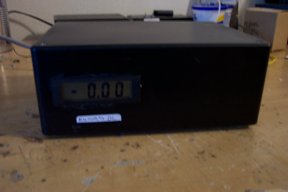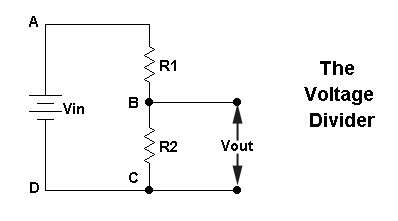

Many of the projects on this site deal with high voltages ranging from a few to several kilovolts. Unfortunately, traditional multimeters can measure voltages up to only about 1,000 volts leaving many of us to crudely estimate voltages by spark gap distances. This project utilizes a simple voltage divider network enabling the measurement of several kilovolts on a stand-alone digital voltmeter.
 A voltage divider is a fundamental electronics principle that basically means that the voltage drop across any resistor is determined by the resistance of both that resistor and the other resistors in the circuit. For example:
Vout=Vin(R2/(R1+R2)
So basically we want Vin to be a very high voltage, say 20,000 V and we want Vout to be low enough to be read by our meter without catching it on fire. So we need to choose R1 and R2 to accomplish this. I chose to use a stand-alone digital voltmeter rather than my multimeter for a couple of reasons. First, if I screwed up the values or something just went plain wrong, I wouldn’t fry my nice multimeter. Second of all, a cheapo digital panel meter only costs like $10 new. Third I figured I would probably want to measure something else at the same time as the high voltage, like current consumption or something so it just makes sense to use a separate meter.
The panel meter I used came from the scrap yard hardly costing a dime. Not sure on the exact specs, but it runs off of 115 AC and has a total range of +/-200 mV. So this means I need to divide 20kV down to 200 mV!
A voltage divider is a fundamental electronics principle that basically means that the voltage drop across any resistor is determined by the resistance of both that resistor and the other resistors in the circuit. For example:
Vout=Vin(R2/(R1+R2)
So basically we want Vin to be a very high voltage, say 20,000 V and we want Vout to be low enough to be read by our meter without catching it on fire. So we need to choose R1 and R2 to accomplish this. I chose to use a stand-alone digital voltmeter rather than my multimeter for a couple of reasons. First, if I screwed up the values or something just went plain wrong, I wouldn’t fry my nice multimeter. Second of all, a cheapo digital panel meter only costs like $10 new. Third I figured I would probably want to measure something else at the same time as the high voltage, like current consumption or something so it just makes sense to use a separate meter.
The panel meter I used came from the scrap yard hardly costing a dime. Not sure on the exact specs, but it runs off of 115 AC and has a total range of +/-200 mV. So this means I need to divide 20kV down to 200 mV!
 There are a couple of points worth mentioning in the resistor section. Even if we calculate the values of the resistors R1 and R2, we probably won’t be able to purchase the exact values we need. And even if we could, the physical resistances will not be exactly what is written on the package due to the tolerances, nominally 5%. To get by with the tolerance, we’ll need to include an additional resistor on R2 that is variable so that we can tune or calibrate the meter when it is complete. The other issue is that we are dealing with very high voltages. Most ˝ Watt resistors are rated for only 500 VDC. If you were to apply 20kV across a normal ˝ watt resistor, a giant arc of plasma would sprout up, ionizing a path of air right around the resistor. So if we stay within the specified limits of the ˝ watt resistor, we’ll need to use at least 20,000/500= 40 resistors in series for this voltage divider network. And that’s exactly what I did. I used 48 1.35 Mohm resistors for R1 and a 5k Variable resistor for R2. To the right is a look inside my kv meter.
There are a couple of points worth mentioning in the resistor section. Even if we calculate the values of the resistors R1 and R2, we probably won’t be able to purchase the exact values we need. And even if we could, the physical resistances will not be exactly what is written on the package due to the tolerances, nominally 5%. To get by with the tolerance, we’ll need to include an additional resistor on R2 that is variable so that we can tune or calibrate the meter when it is complete. The other issue is that we are dealing with very high voltages. Most ˝ Watt resistors are rated for only 500 VDC. If you were to apply 20kV across a normal ˝ watt resistor, a giant arc of plasma would sprout up, ionizing a path of air right around the resistor. So if we stay within the specified limits of the ˝ watt resistor, we’ll need to use at least 20,000/500= 40 resistors in series for this voltage divider network. And that’s exactly what I did. I used 48 1.35 Mohm resistors for R1 and a 5k Variable resistor for R2. To the right is a look inside my kv meter.
It is also important (if you are using a digital meter) to have the negative high voltage input terminal at ground potential. If you do not, even though the voltage difference across the voltmeter is only like 200 mV, both terminals could be several thousand volts above ground level. This is bad when your voltmeter starts arcing internally because it has 115 VAC on one of its terminals and a few thousand volts on another terminal. Believe me, I speak from experience. I have one less digital voltmeter now that I did before I corrected this problem.
So now that things are functioning as they should, it is now time to calibrate the unit against a standard voltage source. I hooked my new 20kV meter up to a 2000 VDC power supply running off a VARIAC. I also hooked up my regular multimeter and dialed in about 800 VDC on the power supply. Measuring the correct voltage with the multimeter, then I dialed in the 20kV meter with the variable R2 resistor so that the unit displayed 0.80 kV.
The author assumes no liability for any incidental, consequential or other liability from the use of this information. All risks and damages, incidental or otherwise arising from the use or misuse of the information contained herein are entirely the responsibility of the user, have a nice day!
Last updated: 05/08/03